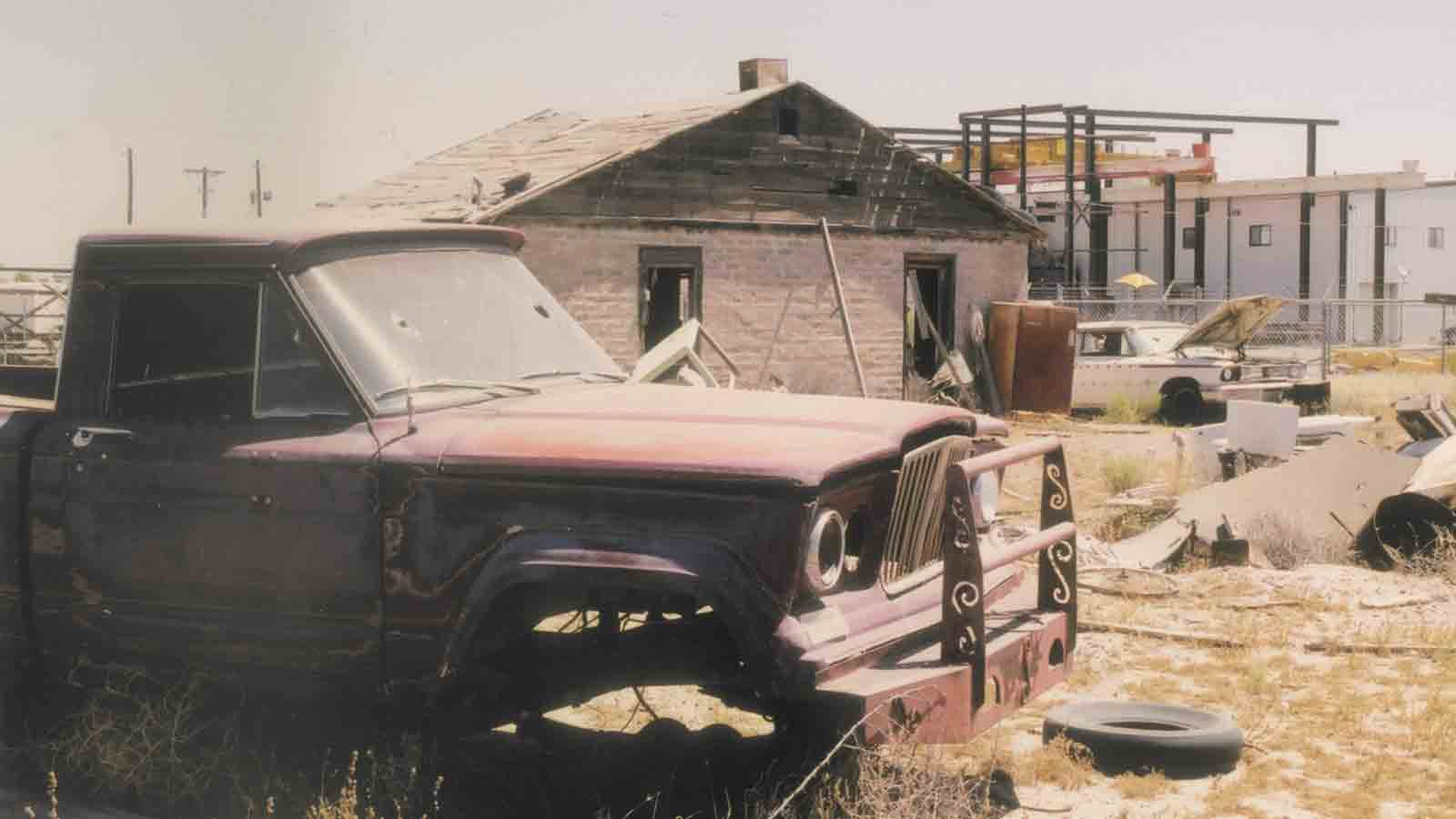Phoenix designer finds fame, fortune on ‘DWTS’
Apr 25, 2012, 7:36 AM | Updated: Jun 4, 2012, 9:35 pm

Tucked into a nondescript set of office buildings in Phoenix is the home office/atelier of designer Randall Christensen, the Emmy Award-winning designer of the skin-baring glitzy gowns and costumes worn on Dancing With the Stars for 11 seasons.
From the street, you’d never imagine what sits beyond the door as you enter Randall Designs. It’s a fantasy world, filled with one-of-a-kind gowns in every color of the rainbow: a moveable feast of rhinestones and feathers and fabrics, each vying for your attention as you sift through the racks.
And yet, it’s not the posh, spacious showroom you might expect from a premier designer. It’s rather humble, really, with just two wall-length racks in a small reception area that could belong to Any Business USA.
But it seems to fit with the humble beginnings of this self-taught designer, whose talent and dedication to his craft has turned his distinct flair for costume design into a burgeoning business and earned him industry accolades as one of the best.
So, how did this country boy from Camden, S.C.(Population: 6,899) end up creating costumes for some of Hollywood’s most high-profile stars?
We talked with Christensen about his rise to stardom as a costume designer and how on earth he ended up in Phoenix…
SF: Randy, how did this all start? How did you go from a little town in South Carolina to designing costumes for ballroom dancers, elite athletes and Hollywood stars?
Randy: It really started when I left for college at BYU.
SF: BYU? Brigham Young University in Utah?
Randy: (laughs) I know, it’s kind of an unlikely route, isn’t it ? But at BYU, I took a couple of ballroom dance classes and I really fell in love with dance. I caught the dance bug and started competing in ballroom dance competitions and eventually became an instructor for a Fred Astaire dance studio. I went back to South Carolina and then got a call from the recruitment people at Fred Astaire because they were opening new studios in Phoenix.
SF: So that’s how you ended up here. Were you still competing?
Randy: Yes, and that’s what really led me into starting to design. The thing about dance competitions is that dancers need to have custom-made costumes; it’s a really important element of competition. And they were very expensive and we were poor as church mice! There were very few designers at the time and nobody could really afford them.
So, I designed a dress for my partner and made it on my mother’s sewing machine. That was the first one I made. My partner really liked it though, and it was very flattering to me since I had no formal training at all.
SF: So, how did you do it?
Randy: I made a pattern on the kitchen table, cut out the fabric and stitched it together! Then, bit by bit, people started coming to me and asking me to design dresses for them. I didn’t even know what to charge them; I was just so flattered that people thought I could do this. So it was basically friends of friends and then one of my students, Zelda Fagen, talked to me about doing this as a business in about 1984.
She and her husband, Bert, loaned me the money to get started and that’s when the business was really born. And you know, I’m still friends with Zelda to this day; she lives in Arcadia.
SF: So now you’ve got a nice little niche business going and you were starting to get noticed?
Randy: Yes, and then we got a call about doing some ball gowns for Jennifer Lopez for the movie, Shall We Dance?. That was our first big break and that led to another opportunity to work on a cable show that was really the predecessor to “Dancing With The Stars,” called “Ballroom Bootcamp” on TLC.
SF: Hmmm, I missed that one.
Randy: It was a little bit of a makeover show. They would have a regular person that would go through the process of learning to dance; of course, they would lose weight and then the show would make over their hair and makeup, and we would make them a glamorous dress and there would be a big reveal, sort of centered around a dance competition.
Then, “Dancing With the Stars” debuted on ABC in 2005. After the first season, they were looking for a new costume designer. Ashley DelGrosso, who was one of the professional dancers on the show, was a client of mine, so she recommended me.
And when we met with the producers, we said, “Oh, well, we’re doing this other show, ‘Ballroom Bootcamp’ and you can watch it on TV tonight and see what we do.” It was kismet. It’s like it was meant to be.
The producers were impressed and Christensen was hired as the lead costume designer for “Dancing With the Stars” for the second season.
Initially, they tried to make the costumes in Phoenix and ship them to the show, but it was a logistical nightmare. So they rented a couple of rooms in what Christensen describes as a “flea-bitten, rag-tag motel” across the street from the studio in Los Angeles.
Working round the clock, he says they were completely exhausted and “living on Red Bull and Vivarin” trying to keep up with the show’s hectic pace.
But despite the squalid conditions, the hard work paid off: Christensen won the Emmy that year for costume design and ultimately secured his position on the show for 10 more seasons.
Although the working conditions improved — they eventually set up shop on set and hired a team of costumers to make the costumes — the grueling pace of the work continued.
Each costume was conceived and created in about a 36-hour time frame, and with multiple costumes per episode in a 15-episode season, the pace was frantic and pressure-packed. And since ‘DWTS’ aired two seasons a year, there wasn’t much time in between for anything else.
At the beginning of the 13th season, the show’s producers approached Christensen with budget cuts, and requested he make changes. Anxious to maintain the level of creativity and quality he had established over the years, it was a deal-breaker and he did not renew his contract.
He was looking forward to a break and working on other projects that had been set aside during his time with the show.
One of those projects, a swimsuit line he designed for Miracle Suit, has just launched and is being sold online at MiracleSuit.com.
Set to launch in June is a line of streetwear called Flatteries. Christensen said his sensibility for enhancing women’s figures, “maximizing the wows and minimizing the woes”, translates easily into the line of separates sold through Shop NBC.
But the bread and butter of Randall Designs continues to be the gowns created for competitive ballroom dancers.
It’s a cottage industry in itself, where top-level competitors can spend thousands of dollars a year on costumes alone, with price tags ranging from $3000 to $6000 apiece, for a custom gown.
Randall Designs also creates custom gowns and cocktail dresses for the socialite set — think Heart Ball — and this segment of the business is one the company sees a lot of growth potential for locally.
Ken Heron, the company’s managing partner for the last 12 years, said women love that they’re able to have a gown or dress completely designed and customized to fit by a designer who’s adept at hiding “flaws” and emphasizing a woman&’s best features.
And one of the first things you notice about a Randall Designs dress is that each one is constructed with an inner bodysuit, designed to nip and tuck where needed; many have built-in bra cups, which can be customized to the wearer’s shape and size and skirt lengths can vary from cocktail appropriate to floor length, in any color you choose.
Randall Designs graciously opened up its showroom for us to photograph some of its most stunning creations, shot on location in Scottsdale at Mabel’s on Main, by local artist and photographer Stephen Moody.
The models are Laura Cotton, a professional ballroom dance instructor and competitor, and Scottsdale resident Diana Motta.

















